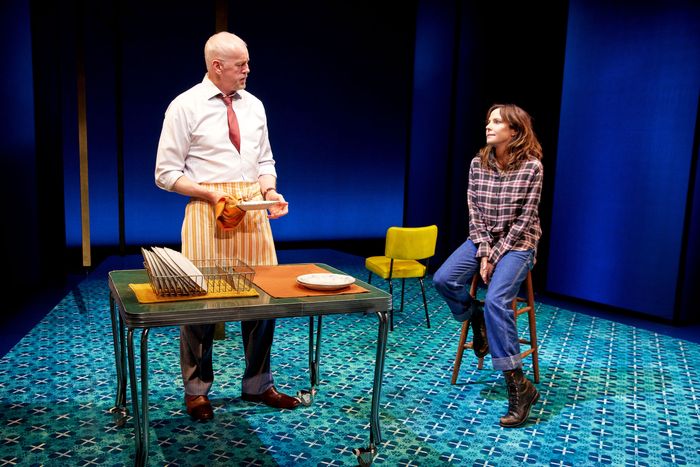
How I Learned to Drive starts on a warm summer night in 1969 — a night, our narrator Li’l Bit tells us, that could make a “middle-aged man with a mortgage feel like a country boy again.” That man, a big lanky fellow, is waiting behind her as she talks to us, sitting in the front seat of a Buick. (The set is simple: just a group of chairs surrounded by glowing screens.) When she joins him in the car, the 17-year-old Li’l Bit and the older man banter and flirt and negotiate. While assuring her that he’s been a “good boy,” he unhooks her bra and manages to get her top off. The night is hot and drowsy — so far, so Americana. And then Li’l Bit calls the man “Uncle Peck.” The first time she says it, your stomach drops. There is worse to come.
Paula Vogel’s play has been around so long, and been so widely studied and awarded, it changed the American theater. When the drama first appeared downtown at the Vineyard Theater in 1997, it crashed through barriers, through taboos, preconceptions, formal cowardice. Dealing with heavy topics like pedophilia and family complicity, its postmodern storytelling was somehow featherlight, even funny. It was accessible and serious, excoriating and full of forgiveness. So in the years that followed — particularly after it won the Pulitzer Prize — the memory play became our pattern book. If it no longer seems groundbreaking, it’s because Drive was groundtilling. A bumper crop of other plays came out of that soil.
Twenty-five years ago, Mary-Louise Parker played Li’l Bit, David Morse played Uncle Peck, and Mark Brokaw directed. Now all three are back for Broadway. Strange things happen when nostalgia gets wrapped up in the production, which is itself a cautionary tale about letting atmosphere (the night, the heat, the past) drug the senses. Drive moves backward in time, revisiting earlier and earlier encounters: What we can just bear to look at when Li’l Bit is 17 gets more awful as she becomes 15, then 13, then 11. The actors, though, have always been adults, so a quarter-century barely makes an ontological ripple for the viewer. Parker has a trick of slumping in a chair and letting her mouth fall slightly open that makes her seem young and dizzy, and it serves her as well in her 50s as it did in her 30s. Morse’s defeated elegance is unaged, and the air of infinite repetition — when did Peck’s hair go white? — makes the dreamy evening feel even more like a visit to the Underworld.
It’s a strangely cheery Underworld, though. Scenes between Li’l Bit and Peck are interrupted by Vogel’s Greek chorus of three (Johanna Day, Alyssa May Gold, and Chris Myers), who play many roles, including those of the rest of Li’l Bit’s family. The text interlaces first-person narration and played-through scenes, alternating emotional drama and chipper informational interludes. Between the uneasy seduction episodes, the chorus offers driving lessons, echoing Peck’s advice to Li’l Bit about idling and when to check your mirrors. It’s a little unfair to the other members of the chorus that one of them is Day. The other two are vivid and efficient, but the radiant Day is actually playing parts and flexing muscles. As Li’l Bit’s mother, she performs the bravura “A Mother’s Guide to Social Drinking,” which contains Vogel’s slyest writing (“Don’t be afraid to dunk your head if necessary. A wet woman is still less conspicuous than a drunk woman!”), and as Li’l Bit’s aunt Mary, she delivers a monologue so bleak she almost stops the show.
Who blames whom for what? Aunt Mary and the family blame Li’l Bit; the girl’s early-onset puberty makes them see her as a grown woman, and they push all their duties of care onto her shoulders. Li’l Bit herself, whose memory directs the plot, snags on moments when her confusion shaded, even briefly, into coquettishness or curiosity. Peck is presented as a tortured and thoughtful person who gives his niece any number of gifts besides the ones she doesn’t want. While the rest of the family shrieks jokes about her breasts, Peck teaches her and listens to her; Vogel refuses to abandon the character, either to our revulsion or his evident monstrousness. In a New York Times interview in 2020, Vogel spoke about the play-as-autobiography and the way she has processed her feelings by watching Morse work. It took her years to admit that the play was based on her own experiences. “I don’t forgive him,” she said of the real person Peck is based on. “But I feel a sympathy, a sorrow, because of David.”
This sympathy drags at the show like an undertow. It threatens to take you out to sea. The play’s formal restraint — the choice to use pantomime instead of actual touching, for instance — makes unbearable scenes watchable, and Parker plays with her attention half toward the audience, glancing at us to see how we’re handling things, one side of her mouth quirked in a half-smile. This puts every scene at arm’s length. Crucially, though, we do see one Peck sequence without Li’l Bit. It’s called “Uncle Peck Teaches Cousin Bobby How to Fish”— and at first it seems just as heated and drowsy and sweet-tenored as that first scene with Li’l Bit in the Buick. Miming his rod and reel, Peck turns his eye to his young nephew (who never actually appears), a little boy too soft-hearted to keep the fish he catches. As we watch in horror, Peck ruthlessly, deliberately, prepares the child to be assaulted. Every expression of support and love he makes is clearly a grooming strategy; without Li’l Bit’s melting gratitude and dissociated sangfroid to play against, Peck’s kindnesses expose themselves as glib and lying and foul.
I realize that doesn’t make it sound like a fun 100 minutes in the theater. And Brokaw’s production does show a few cracks: The glowing screens (designed by Rachel Hauck) are unhandsome; David Van Tieghem’s sound design does not always amplify the actors sufficiently. But the chance to see these performers doing such incandescent work should shoulder all such concerns aside. See it for Parker, see it for Morse. Drive is also — and I’m sorry this is such an uncool way to put it — the truth. We have been surrounded in recent months by variously hysterical and inaccurate claims from politicians and blowhards about what counts as child endangerment. Vogel, with all her postmodern tricks, is offering a straightforward account of how these things happen. A girl is in peril, and although the people around her all sense it, they actively push her further into harm. “Sometimes to tell a secret, you first have to teach a lesson,” says Li’l Bit. That’s the lesson in the play, surely, one far more important than the ones the U.S. theater has so dutifully learned from Vogel’s writing style: Look at the thing that people tell you to keep hidden — and describe it as it really is.
How I Learned to Drive is at the Manhattan Theater Club’s Samuel J. Friedman Theatre.


